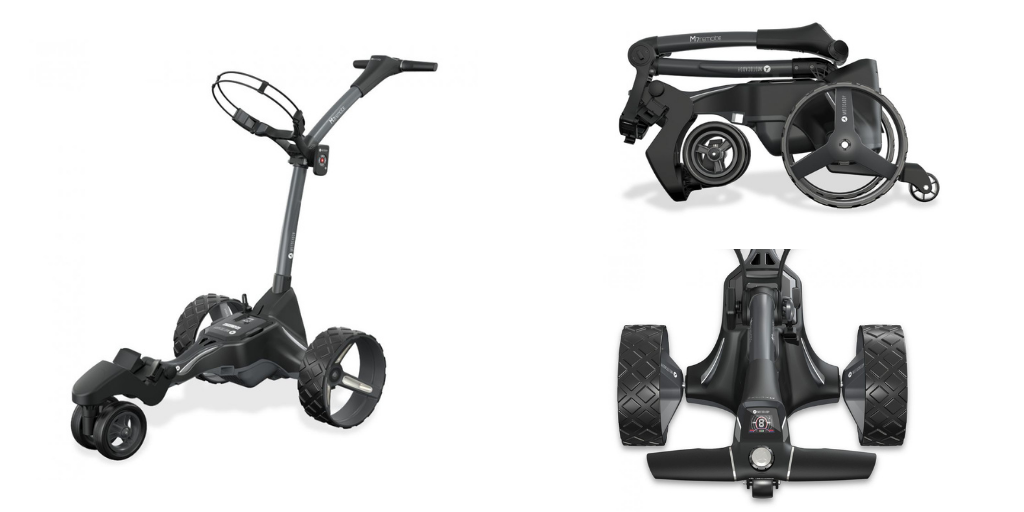
I try to keep track of trends in the golf industry to see what products interest me and review them for the site. Over the past 5+ years, I've noted the technological advancements in the electric cart space (also referred to as electric caddies). Years ago, I noticed the early adopters driving massive tanks around the golf course that cost thousands of dollars, had poor battery life, and were an eyesore. Now, elegantly designed carts have much better features, longer battery lives, and don't cost exorbitant amounts of money.
The Promise of Electric Caddies
Since walking the golf course is more popular in regions like the UK and Australia, manufacturers like Motocaddy, MGI, and Stewart have had many successes in those markets. But you rarely saw them in the United States. However, I noticed in 2020, and even more so in 2021, these products are starting to pop up everywhere I go.
I feel like we're at an inflection point, and the demand is starting to build. There's no question that the restrictions placed on golf courses last year during the beginning of the Covid outbreak helped fuel demand, but I do think that beyond that, walking habits are starting to change.
I'm all for it because I believe every golfer should walk the course if they can. I believe it's a far better experience, and the exercise is massively beneficial. For many golfers, having the assistance of motorized carts can make that experience more seamless and less physically demanding (especially for courses with more challenging terrains).
Perhaps my best litmus test for any product category is that I really wanted to try out some of the models. For years I've used normal pushcarts, and I wondered how much better walking the course would be if I could have a totally hands-free experience, similar to taking a caddy.
So for the past two months, I've been testing what many believe is the industry-leading electric caddy, the1234 Motocaddy M7 REMOTE Product Link.1234 I have quickly fallen in love with this product and the hands-free experience it provided me on the golf course. I'm not sure I can ever go back! Interestingly, I got tons of questions from golfers who saw me with it on the course. It seemed like many of them had been thinking about electric caddies and doing some research of their own.

In this review, I'll go over the Motocaddy M7 REMOTE'S main features and try to help you decide if it's worth your significant investment - $1,499. Throughout the past seven years, I've tested many products; this is genuinely one of my favorites.
Setting Up the Motocaddy M7 REMOTE
One thing people should be aware of is that the Motocaddy M7 is not exactly light. It weighs more than 30 pounds with the battery attached, so it's something to be aware of when taking it in and out of your car. It also is on the larger side, so depending on your trunk, you may or may not have enough room for your golf bag and the M7. It does have a feature that allows the larger wheels to fold in to make it more compact.
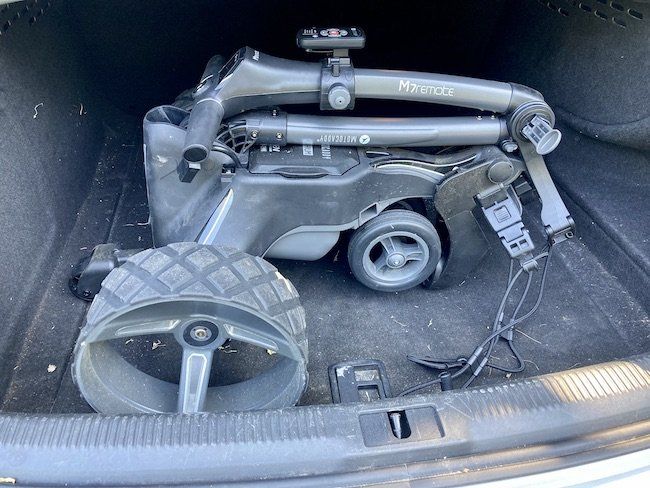
Opening and closing the Motocaddy M7 REMOTE is a breeze. You have to lock and unlock two handles, but it takes less than 30 seconds to get it ready for your golf bag.
I did appreciate the large base at the bottom to accommodate different styles of bags. I have a Jones Sports Utility bag and had no issues securing it to the base and the two adjustable bag supports. I've found that with other pushcarts and electric caddies, especially with stand bags, they won't fit properly, and it's a pain to get them secured. Certainly not the case (at least for my bag).

Motocaddy does have its own modular bag system called EASILOCK™. It locks the lower portion of their own bag into the base unit and only requires securing the top support strap. I wouldn't say it's necessary to have their bag, but it is a nice feature.
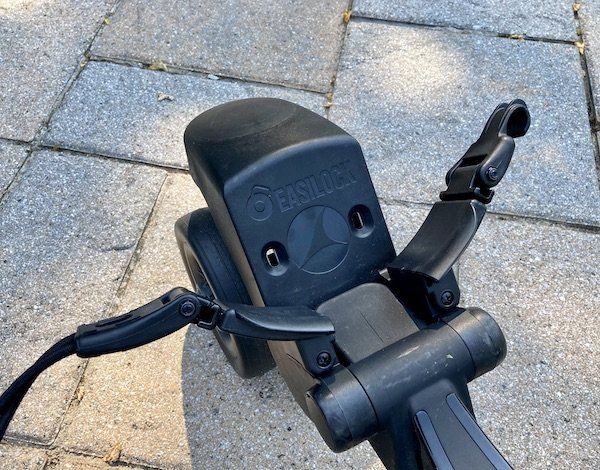
Other than unfolding the M7, securing your bag, and plugging in the battery, there isn't much else to do to get up and running. It's a seamless process and was even faster for me than my Clicgear 3.5 pushcart.
In a tournament I played, I found out that the weight distribution in your bag can affect its performance. There was a threat of rain, so I stuffed all kinds of rain gear and extra gloves into one side of my bag. Because the weight was so lopsided, it made the M7 steer slightly in one direction, which they warn of in the instruction manual. So if you do plan on packing tons of water, snacks, and other gear, you should try to make sure it is evenly divided into both sides as much as you can.
The only feature I missed from my Clicgear 3.5 pushcart was extra storage. The Motocaddy M7 REMOTE does not come with any storage compartments or nets. It does have the ability to attach drink holders, and a few other accessories, but I imagine someone could get creative with clipping on a mesh bag, or something similar to have quick access. But for the most part, it wasn't too big of a nuisance accessing the storage of my golf bag.
Operating With Remote
I would say about 90% of the time I operated the Motocaddy M7 via the remote. While it took a little getting used to, I found that it became a "passive" part of my round and capitalized on the freedom of walking that I was looking for. It was awesome!
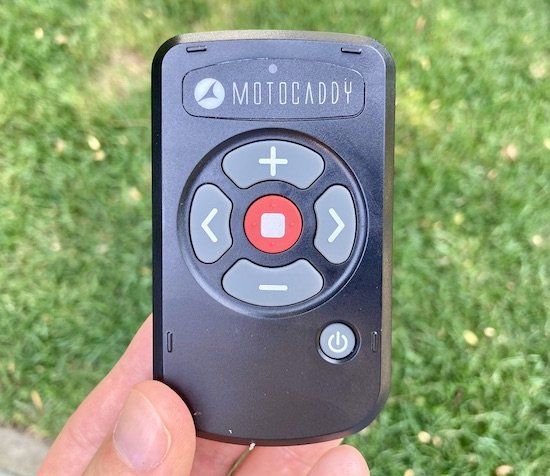
The remote is pretty straightforward to use and quite responsive to whatever steering directions you give it. The range is exceptional as well. On certain holes at my course, I opted to leave the cart in between holes and could easily move it around from as far as 100 yards away without issue.
Here are some videos I shot of the M7 in action, which show just how agile it is while using the remote control:
At first, I was a little extra careful on how long I would watch the caddy travel while steering it to the next tee box as I approached the green. Honing in on an appropriate speed took a little trial and error (usually, I have it set to a 4 or 5). There are nine-speed settings, so however fast or slow you walk on the course, you'll be able to find a number that works for you. Additionally, I tested it on various hills and slopes, and started to learn what it could and couldn't handle. However, I found that even if I were going a little too fast downhill, the M7 would automatically adjust its speed to make sure it wasn't going to tip over.
After a few rounds, I built the remote into my routine. For example, on approach shots, I had a habit of clipping the remote onto the cart (very easy to do) as I approached my bag. As I walked to the green, I would use the remote to park it in an appropriate spot, engage the lock button, and clip it into my back pocket.
The only minor complaint I have is that the locking button could be a little larger; sometimes, I wasn't sure if I engaged it or not and would have to refer to the color of the light (red or green) to see if the M7 was locked, which would avoid any accidental driving.
Overall, after about four to five rounds, I felt completely comfortable using the remote pretty much all the time. Walking around the course hands-free was amazing and allowed me to engage in my round with a bit more freedom.
More importantly, the Motocaddy M7 REMOTE is a bit of a tank. One worry I had on my course, which is extremely hilly, is that it would tip over. Whether traveling uphill, downhill, or sideways on a slope, I never felt that I was out of control with the M7. The anti-tip wheel on the back will prevent the M7 from falling backward, but to be honest, I never got in a situation where it was ever engaged much.

This does take a little bit of skill with knowing what speeds it can handle, but I would say its main strength is its sturdiness compared to another model I tested.
Operating With Manual Control
One of the great features of the Motocaddy M7 REMOTE is that you can seamlessly transition from using the remote to manual mode. There is a small dial on the top of the cart, which you can press to start or stop the cart and rotate to change your speed. Once you engage the manual control, you can steer the cart as you would with a normal pushcart, but without the need to exert any force to keep it moving.
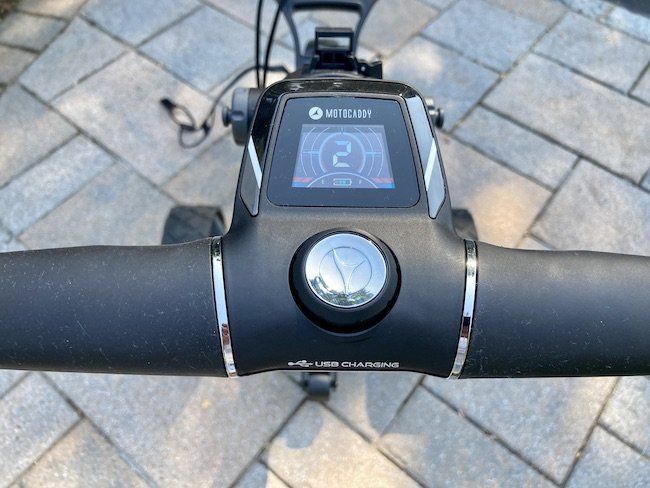
Some golfers might use manual mode more than me, but I found that I would only use it when operating on more extreme terrains or navigating going over a curb or some other kind of obstruction. Either way, you'll quickly get used to switching between the remote and manual mode as the design is very intuitive.
The Battery Is Exceptional
The Motocaddy M7 does require charging a lithium battery (as well as the remote). The battery itself is straightforward to connect, neatly designed, and turns off rather quickly when not in use. When you take it out of your car, you'll plug it in and then remove it once your round is over. Another nice feature is that the battery has an IP66 rating so that it can withstand heavier rain.

The thing that worried me the most is that I would be on the course and the battery would run out of charge. Moving the M7 around without the motor running is a bit tedious. The amount of battery life you have left is clearly displayed on the LCD screen. There also is an extra USB port that can charge the remote or other devices like a phone.
In my testing, I walked three 18-hole rounds that were about 4 hours each, and the battery still showed a 50% charge. I didn't want to press my luck any further, so I decided to recharge at that point. Over time, you can probably expect the battery to lose its charge as all lithium batteries do. Still, Motocaddy does recommend charging at the end of every round to protect its longevity. You can charge rather easily with the battery connected to the cart (perhaps in your garage) or remove it.
I chose to leave the M7 in my trunk and take the battery out to charge. Remembering to charge the battery after your rounds is the only extra downside of using a product like this, but like anything else, if you build it into your routine, it is worth the trouble.
Motocaddy M7 vs. MGI Zip Navigator
If you've done your research on electric caddies, you are probably deciding between the Motocaddy M7 REMOTE and MGI Zip Navigator. That shouldn't come as a surprise since both are priced the same ($1499) and have almost exactly the same features.
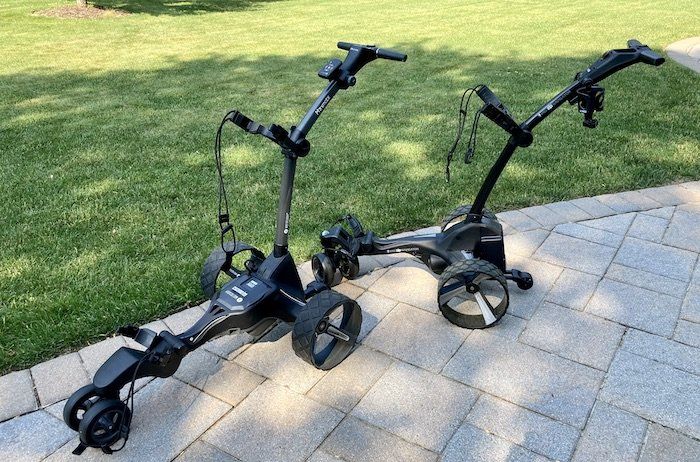
After using each model extensively, I can tell you they are both exceptional products, and golfers will be happy with either. However, if I'm nitpicking, I would choose the Motocaddy M7 REMOTE over the MGI Zip Navigator for two main reasons:
- The Motocaddy M7 is sturdier: In my testing, I never did tip the MGI Zip Navigator over, but I noticed it was a little more unstable on uneven terrains when operating at a faster speed. The M7 seems to have a stronger base that resists tipping more.
- My bag attaches more easily: This might vary based on what bag you are using, but the base of the M7 was more accommodating to my stand bag. I found that I had to re-adjust my bag several times a round with the MGI Zip Navigator.
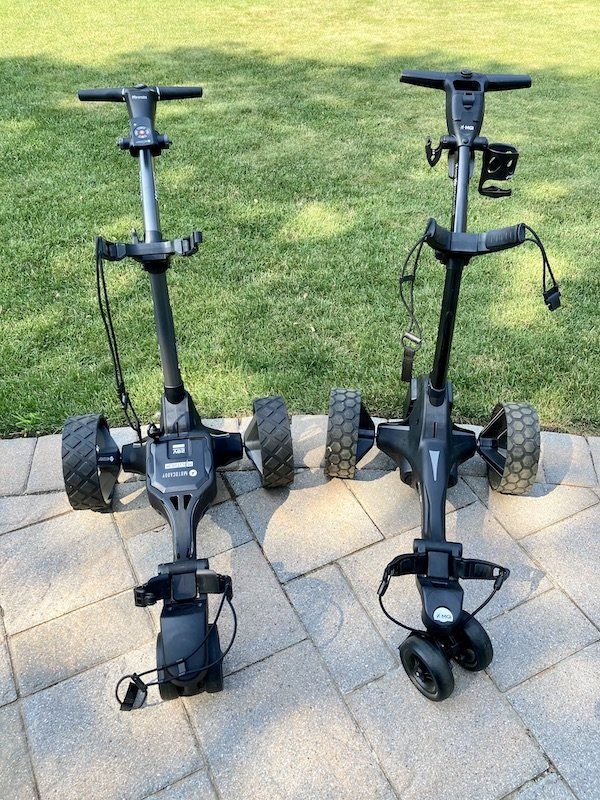
Should You Buy An Electric Caddy?
As you can tell, I am a complete convert at this point. I genuinely feel having an "electric caddy" makes walking the golf course more pleasant. Walking without carrying a bag or pushing a cart is amazing. Additionally, the Motocaddy M7 REMOTE seems to be the best all-around product in the category for the price and features.
So I can wholeheartedly recommend this product to you, but of course, the question is, "is it worth spending $1499?"
That's a bit harder for me to answer. You can easily purchase a regular pushcart for as little as $150 - $200 and get all of the benefits of walking the golf course without the strain of carrying your bag. And for many, this is probably the best option. A product like the Motocaddy M7 REMOTE is a luxury, not a necessity.
For those who might struggle a little physically, even with a pushcart, I would tell you that an electric caddy did save me a ton of energy. My golf course is physically taxing with tons of hills, and even though I'm in good physical condition, I'd rather save that energy for my swing. Not having to push my regular cart up a hill was nice. Especially in the summer months when I'm dealing with excessive heat and humidity.
So I would say if you have the budget, the Motocaddy M7 REMOTE is a great long-term investment. It will enhance your experience on the golf course, and more importantly, I think it will get you walking more. People don't realize just how beneficial walking the course is for your health, and for someone a little obsessed with exercise and general well-being, I genuinely think this product category can do some real good for people's lives. Walking the golf course is the way to go!
If you are interested in purchasing the Motocaddy M7 we have a special bundle for Practical Golf readers for $1499 here.
We care about the protection of your data Read our Privacy Policy